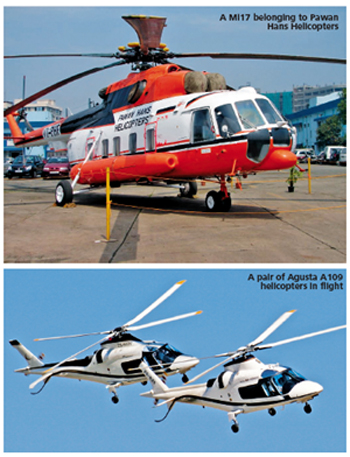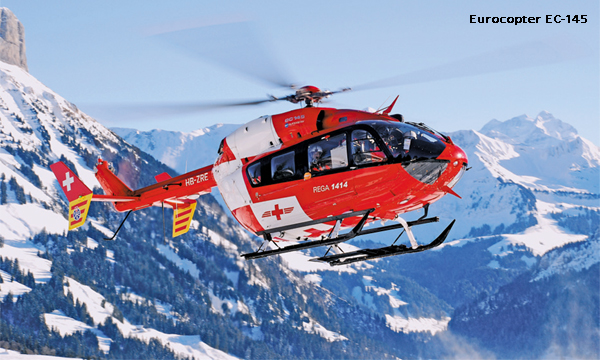|
Just to put this figure into perspective, Air
Methods, a US based helicopter operator specialising
in Helicopter Emergency Medical Services (HEMS),
operates Eurocopter and Bell rotary wing machines
totalling, at the time of writing this, to 450
(almost double of India’s total civil helicopter
strength). General aviation in India (with business
aviation forming a sub-set thereof) has had a
stunted growth over the past decade due to a variety
of reasons. Within general aviation, helicopters
have had more than a fair share of adversity.
There have been unfortunate accidents, the numbers
have declined since 2008, pilot training has been
almost non-existent, infrastructural woes have
doggedly pursued rotary wing operations, and regulatory
apathy has aggravated the plight of helicopter
operations to a plaintive one.
 The
regulatory framework in India is a bit frail with
respect to rotary wing operations. The existing
content of Civil Aviation Requirements (CARs)
and circulars is a bit spread out and lacks mutually
exclusive comprehensiveness. DGCA is working on
a draft CAR Ops 3 to deal with helicopter operations
comprehensively. The title of this document un-disguisedly
defers to Europe’s JAR Ops 3 (JAR is Joint
Aviation Requirements for the erstwhile Joint
Aviation Authorities, now reorganised as European
Aviation Safety Agency); so does the content.
The draft is a 465 page document which most helicopter
operators in India feel is a bit of overkill with
minimal relevance to the Indian context. Whether
the new CAR will make regulation easier or more
complicated is for time to reveal. The other government
agency promulgating policy on rotary wing operations
is the Airports Authority of India (AAI). In response
to constant complaints from the helicopter operators,
had issued Aeronautical Information Publication
(AIP) Supplements laying down some instructions
for routing helicopters in the vicinity of metro
airports. However, Air Traffic Controllers (ATC)
in the employ of AAI are themselves reluctant
to follow these instructions which would ease
helicopter operators’ travails but would
increase workload for the controllers (Mumbai
and Delhi are the main pain areas). A constant
refrain from helicopter pilots is that Controllers
tend to apply rules designed for fixed wing operations
to rotary wing ones and that causes practical
problems. The
regulatory framework in India is a bit frail with
respect to rotary wing operations. The existing
content of Civil Aviation Requirements (CARs)
and circulars is a bit spread out and lacks mutually
exclusive comprehensiveness. DGCA is working on
a draft CAR Ops 3 to deal with helicopter operations
comprehensively. The title of this document un-disguisedly
defers to Europe’s JAR Ops 3 (JAR is Joint
Aviation Requirements for the erstwhile Joint
Aviation Authorities, now reorganised as European
Aviation Safety Agency); so does the content.
The draft is a 465 page document which most helicopter
operators in India feel is a bit of overkill with
minimal relevance to the Indian context. Whether
the new CAR will make regulation easier or more
complicated is for time to reveal. The other government
agency promulgating policy on rotary wing operations
is the Airports Authority of India (AAI). In response
to constant complaints from the helicopter operators,
had issued Aeronautical Information Publication
(AIP) Supplements laying down some instructions
for routing helicopters in the vicinity of metro
airports. However, Air Traffic Controllers (ATC)
in the employ of AAI are themselves reluctant
to follow these instructions which would ease
helicopter operators’ travails but would
increase workload for the controllers (Mumbai
and Delhi are the main pain areas). A constant
refrain from helicopter pilots is that Controllers
tend to apply rules designed for fixed wing operations
to rotary wing ones and that causes practical
problems.
Infrastructure for rotary wing operations is
another weak area. Most operators are inclined
to take risks in the interest of operational (read
revenue) expediency. Hence there are shortfalls
and serious safety lapses at helipads which are
spread out all over the vast expanse of the country.
DGCA, with all good intent, is unable to inspect
the existing plethora of permanent helipads, not
to mention the ones that come up at short notice,
to ensure that prescribed safety levels are maintained.
This is so because of the shortage of trained
manpower that afflicts DGCA. Given the nature
of helicopter operations, constant monitoring
is well nigh impossible. Moreover, quite often,
the pilots are under enormous pressure to fly
through adverse weather, especially when politically
or commercially important persons push them to
meet their itineraries with disregard to air safety
considerations. The sad losses of GMC Balayogi
(Lok Sabha Speaker), Dorji Khandu (Arunachal Pradesh
CM), YS Rajashekhara Reddy (Andhra Pradesh CM),
OP Jindal (Haryana Power Minister), and Dera Natung
(Arunachal Pradesh Education Minister) come to
mind as possible cases where pressure, applied
by the VIP on board, or perceived by the pilots,
led to unfortunate accidents. One of the reasons
for this state of affairs is that there are more
than one agency/Ministry involved in infrastructural
development and upkeep. The New Prime Minister
has mooted the idea of a committee of infrastructure
ministers under Nitin Gadkari to meet once a month
for coordination functions. It is hoped that some
improvement will take place in the safety and
operational efficiency of helicopter operations
also as a result.

The pattern for Indian civil helicopter operations
is at variance with global indicators. Around
29 per cent of world’s civil helicopters
are used for HEMS (Helicopter Emergency Medical
Services) and Airborne Law Enforcement (ALE),
but in India, this use is negligible. Although
there have been sporadic attempts to get HEMS
off the ground, there is no big player yet on
the scene; Bangalore-based Aviators India is serious
about HEMS and may well be the first one to introduce
it in India. Law enforcement has largely ignored
the potential of the helicopter, but the push
against Maoists in 8 states has led to Border
Security Force (BSF) acquiring its own Mi-17 V5s
(after having seen Indian Air Force (IAF) Mi-17
V5s in action against militants on the ground).
Some states are also contemplating acquiring helicopters
for this role. This trend of using helicopters
against militancy is likely to grow unless significant
success is achieved against Maoists. However,
this role is not the same as ALE for which there
is hardly any use of helicopters in India; none
of the large metropolitan city police forces have
any helicopters although some have contingency
plans to use civil use helicopters in emergencies.
About 40 helicopters are engaged in off-shore
operations; these carry out three-fourths of the
total rotary wing flying across the country. The
bulk of the remainder are used for non-scheduled
operations or private use (including business
use). A large proportion of helicopters used for
private (or business) purposes have been converted
to non-scheduled operations since 2007 when the
government decided to impose a hefty duty on aircraft
imported for private/ business use while keeping
the duty on aircraft imported for non-scheduled
use at a very low figure. Business houses circumvented
the higher duty by seeking permission to operate
as non-scheduled operators; many helicopters being
used for business purposes continue to ply under
the garb of non-scheduled operations.
It is difficult to distinguish between genuine
non-scheduled operations and business use as some
business use is disguised as non-scheduled operations
by raising internal invoices and affecting internal
payments. The actual use on non-scheduled operations
i.e. charters, tourism etc cannot be determined
accurately except in the case of apparent use
for this purpose like in Vaishno Devi, Kedarnath
and Amarnath. A mention needs to be made of the
extensive use of helicopters during a build up
to elections, as was the case in April-May this
year. There is a huge potential for use of helicopters
for carriage of passengers between places with
road/rail distances of 400 km or less. For such
distances the time saving is impressive, especially
if one of the places being connected is a metro
or a big city. The other kind of flights where
helicopters are particularly useful is one in
a hilly terrain e.g. the Katra-Vaishno Devi helicopter
flight takes 5 to 8 minutes but saves hours of
arduous walking over a hill side. However, while
both these types of opportunities exist in abundance,
the growth of helicopter numbers has not matched
the potential.
There is nothing mystifying about the reasons
for this slow growth. Besides the infrastructural
and regulatory woes described above, there is
also the high cost of fuel which adds to the high
cost of operation for helicopters (as compared
to fixed wing for carriage of the same payload
over the same air distance). Maintenance costs
are high as government policies on Maintenance
Repair and Overhaul (MRO) facilities are myopic
and the high taxation is a burden on the end user
i.e. the helicopter operator. There is also the
fact that there is negligible rotary wing pilot
training available in India. There are 40 flying
training institutions approved by DGCA according
to the DGCA site but the only one carrying out
helicopter pilot training is HAL Rotary Wing Academy.
However, its course duration is 18 months for
a Commercial license and its meagre intake includes
Army, Navy and Coast Guard pilots, leaving civil
aspirants to head abroad for very expensive training.
Pawan Hans Helicopters Limited (PHHL), a helicopter
company which is jointly owned by Government of
India and Oil & Natural Gas Commission (ONGC),
and operates 47 helicopters, had declared its
intent (about four years ago) to set up a helicopter
training academy at Hadapsar (near Pune). However,
the plan is yet to materialise into a real project.
While on the subject of training, it is worth
mentioning the contribution of ‘Helicopter
Academy to Train by Simulation Of Flying’
(HATSOFF), a joint venture between HAL and CAE
Inc (a Canada-based aviation simulator producer),
towards simulator training of pilots flying the
Bell 412, Eurocopter Dauphin, and the Dhruv.
Coming to helicopter manufacturing industry,
India belongs to a small elite group of nations
producing helicopters. However, the Dhruv ALH
(Advanced Light Helicopter), a 5.5-tonne, twin-engine,
multi-role helicopter is the only design that
Hindustan Aeronautics Limited (HAL) can claim
as its own, the other helicopters it produces
being manufactured under license or as modifications
to existing foreign types of helicopters. A quick
scroll down the aircraft register provided by
DGCA reveals that no non-scheduled operator uses
a Dhruv, its only users being the Jharkhand Government,
Oil & Natural Gas Commission, and HAL Itself.
The Geological Survey of India has declared its
intent to use a Dhruv for aerial surveys.
It does not look likely that in the next decade,
HAL will fabricate a new design that will provide
Indian operators with an inexpensive alternative
to the foreign helicopters in use in India. Meanwhile,
Bell, Sikorsky, MD, AgustaWestland, Eurocopter
(now Airbus Helicopters) have their commercial
presence in India with Eurocopter having set up
a full-fledged Indian subsidiary, the first foreign
helicopter manufacturer to do so in India.
So what is the next decade likely to be for
civil helicopters in India? There is no doubt
that civil helicopter operations need to rise
above their nascent stage and bloom to their full
potential. However, regulatory and infrastructural
road blocks have to be cleared for that consummation
to occur. The signals from the new government
are all positive so far. It is hoped that civil
aviation will also venture upon “Achchhe
Din” (good days) in the near future. All
stakeholders in the civil helicopter industry
await, with bated breath, the instatement of an
environment conducive to their growth to their
full potential.
|